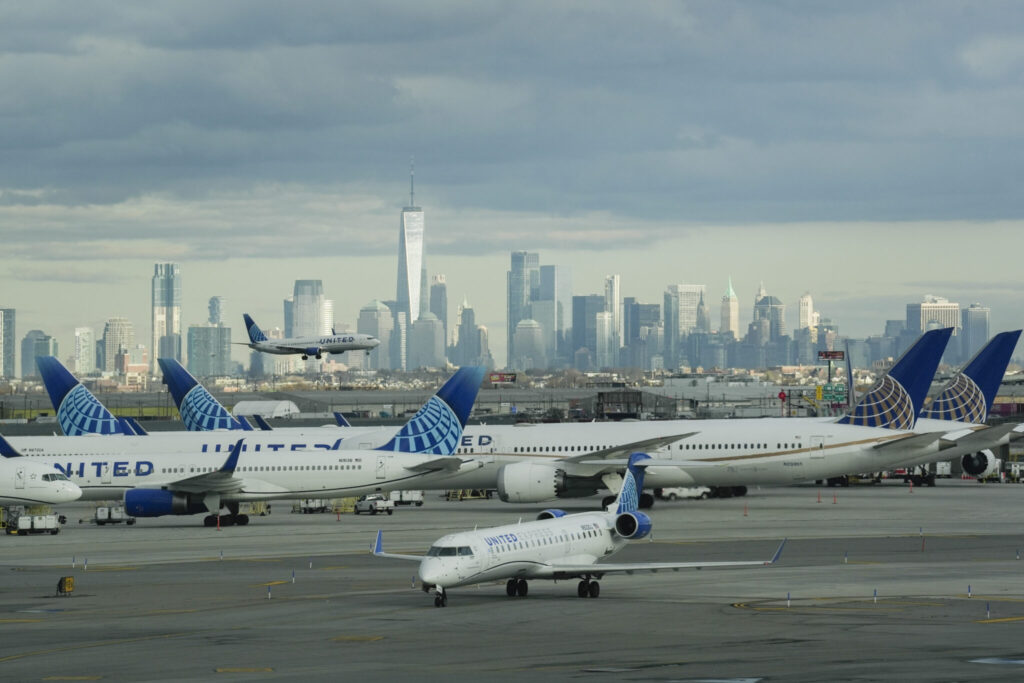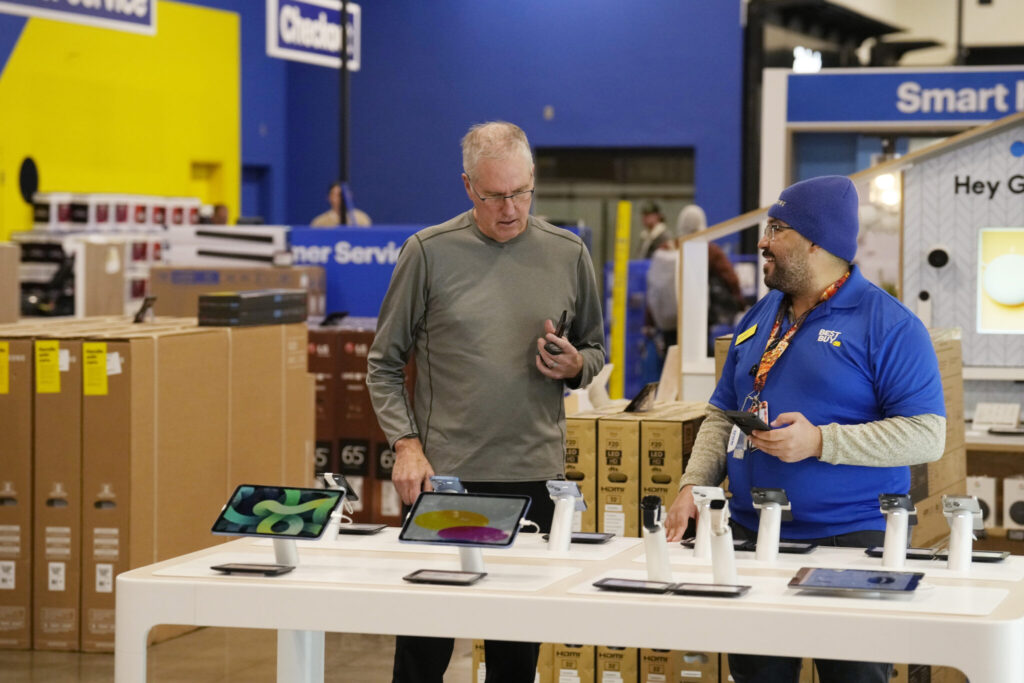The Federal Reserve’s preferred inflation measure cooled last month, the latest sign that price pressures are waning in the face of high interest rates and moderating economic growth. Thursday’s report from the Commerce Department said prices were unchanged from September to October, down from a 0.4% rise the previous month. Compared with a year ago, consumer prices rose 3% in October, below the 3.4% annual rate in September. That was the lowest year-over-year inflation rate in more than 2 1/2 years.
Quick Read
- Inflation Measure Shows Cooling: The U.S. Federal Reserve’s preferred inflation gauge indicates a cooling trend in price pressures due to high interest rates and slower economic growth.
- October Price Changes: Prices were unchanged from September to October, a decrease from the 0.4% rise in the previous month, with an annual consumer price increase of 3%.
- Core Prices Slowdown: Core prices, excluding food and energy, rose by 0.2% from September to October, with a 3.5% increase over 12 months, signaling a slowdown.
- Fed’s Expected Response: With inflation easing, the Fed is anticipated to keep its key rate unchanged in the upcoming meeting, diverging from its earlier projected inflation levels for late 2023.
- Factors Influencing Inflation: Declining gasoline prices contributed to inflation slowing, while grocery prices continued to rise, albeit at a slower pace than last year.
- Fed’s Rate Hikes Since March 2022: The Fed has increased its key rate 11 times since March 2022 to about 5.4%, with expectations of a potential rate cut as early as late spring.
- Fed Official’s Optimism: Fed official Christopher Waller hinted at the possibility of a rate cut by spring if inflation continues to decrease.
- Consumer Spending and Economic Growth: Consumer spending rose modestly by 0.2% last month, with the economy growing at a 5.2% annual pace from July to September.
- Slowing Growth in Current Quarter: Economists predict a significant slowdown in growth for the current quarter due to the impact of higher borrowing rates.
- Pandemic’s Role in Inflation Surge: Inflation escalated during the pandemic due to increased consumer spending and global supply chain issues, compounded by Russia’s invasion of Ukraine.
- Inflation Peak and Fed’s Goal: Inflation peaked at 7.1% in June 2022, with the Fed’s rate hikes aimed at slowing the economy to control inflation.
- Persistent High Prices: Despite cooling inflation, prices remain significantly higher than pre-pandemic levels, impacting consumer outlook.
- Expectations for Inflation Reduction: Economists anticipate a steady decline in inflation to the Fed’s 2% target, with real-time data showing decreasing new rent costs.
- Fed Officials’ Optimism on Inflation Outlook: Some Fed officials, including Waller, express confidence in the effectiveness of the Fed’s policies in reducing inflation to 2%.
- PCE Index vs. CPI: The personal consumption expenditures price index, preferred by the Fed, differs from the consumer price index, which showed a 3.2% rise in October year-over-year.
The Associated Press has the story:
Fed Reserve’s preferred inflation gauge shows price pressures continuing to cool
Newslooks- WASHINGTON (AP)
The Federal Reserve’s preferred inflation measure cooled last month, the latest sign that price pressures are waning in the face of high interest rates and moderating economic growth.
Thursday’s report from the Commerce Department said prices were unchanged from September to October, down from a 0.4% rise the previous month. Compared with a year ago, consumer prices rose 3% in October, below the 3.4% annual rate in September. That was the lowest year-over-year inflation rate in more than 2 1/2 years.
Excluding volatile food and energy costs, increases in so-called core prices also slowed. They rose just 0.2% from September to October, down from a 0.3% increase the previous month. Compared with 12 months ago, core prices rose 3.5%, below the 3.7% year-over-year increase in September. Economists closely track core prices, which are thought to provide a good sign of inflation’s likely future path.
With inflation easing, the Fed is expected to keep its key benchmark rate unchanged when it next meets in two weeks. The latest figures also suggest that inflation will fall short of the Fed’s own projected levels for the final three months of 2023.

In September, the Fed’s policymakers had predicted that inflation would average 3.3% in the October-December quarter. Prices are now on track to rise by less than that, raising the likelihood that Fed officials will see no need to further raise interest rates.
Helping slow inflation last month was a decline in gasoline prices. From September to October, the price of gas tumbled 4.9%. Prices at the pump have fallen further this month, to a national average of $3.25 a gallon Thursday, according to AAA.
Grocery prices, though, edged up 0.2% last month and were 2.3% above their average costs 12 months earlier. Those price increases, though smaller than they were last year, are still faster than was typically true before the pandemic.
Some individual grocery items rose sharply last month: Beef jumped 1.2% from September to October. Milk and processed fruits and vegetables rose 1%. Grocery prices overall are up 23% from their pre-pandemic level.

Since March 2022, the Fed has raised its key rate 11 times from near zero to roughly 5.4% in its drive to curb inflation. Most economists think its next move will be to cut rates, with the first cut possibly occurring as early as late spring.
On Tuesday, Christopher Waller, a key Fed official, suggested that a rate cut is possible by spring if inflation continued to head lower. Waller sounded the most optimistic notes of any Fed official since the central bank launched its streak of rate hikes, and he signaled that the rate increases are likely over.
On Wednesday, the government reported that American consumers spent enough to help drive the economy to a brisk 5.2% annual pace from July through September. In Thursday’s report, the government said that consumer spending last month rose a modest 0.2%.
Most economists say growth is likely slowing sharply in the current October-December period from the cumulative effects of higher borrowing rates on consumer and business spending.
Inflation rocketed up during the pandemic as cooped-up Americans ramped up spending on furniture, appliances, and electronics just as global supply chains became snarled and unable to meet the accelerating demand for goods. Russia’s invasion of Ukraine also escalated food and energy costs.
Inflation, according to the Fed’s preferred gauge reported Thursday, peaked at 7.1% in June 2022. The central bank’s rate rate hikes have elevated the costs of mortgages, auto loans and other forms of consumer borrowing as well as business loans. The Fed’s goal in tightening credit has been to slow borrowing and spending cool the economy and tame inflation.

Even as inflation has cooled, overall prices remain much higher than they were before the pandemic erupted in February 2020, leaving many Americans with a gloomy outlook on the economy. Consumer prices are still about 19% higher than they were right before the pandemic struck. Most Americans’ wages have risen slightly more than that. But inflation-adjusted wages haven’t increased as quickly as they did before the pandemic.
Still, most economists say they are now confident that inflation will fall steadily to the Fed’s 2% target over the next year or so. Real-time data shows that the cost of new rents, one of the largest components of the government’s price indexes, have fallen steadily. Over time, those figures feed into the government’s measure and should contribute to lower reported inflation.
Some Fed officials are sounding more optimistic about where they think inflation is headed. In his remarks Tuesday, Waller said he was “increasingly confident” that the Fed’s interest rate policies are “well-positioned to slow the economy and get inflation back to 2%.”
The U.S. inflation gauge that was issued Thursday, called the personal consumption expenditures price index, is separate from the government’s better-known consumer price index. The government reported earlier this month that the CPI rose 3.2% in October from 12 months earlier.
The Fed prefers the PCE index in part because it accounts for changes in how people shop when inflation jumps — when, for example, consumers shift away from pricey national brands in favor of cheaper store brands.






